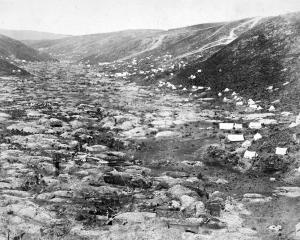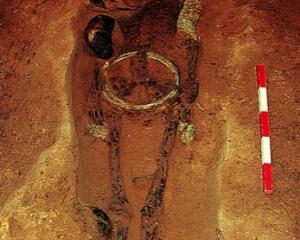In 1983, my Thai colleagues in Bangkok told me about a newly discovered prehistoric site just an hour’s drive away. The following day they drove me there and I was amazed by the sight of a huge mound rising up from the flat plain, like a stranded whale. A small square opened by a local teacher was still open, and I clambered down the ladder into the inky depths fully 9 metres deep of cultural remains. This site, Khok Phanom Di, was to become my personal Everest. On December 26 the following year, I returned with a large team of Otago students and Thai colleagues to open a square covering 100 square metres. We finally reached the bedrock on July 17 the following year. This site once lay on a mangrove-fringed estuary and was occupied by a community of rice farmers for about 20 generations, starting in 2300 BCE. The mound accumulated so rapidly, that they interred their dead over the ancestors, and I want to concentrate on just two of the many graves we uncovered.
The first contained the skeleton of a small woman, accompanied by a pottery vessel. As we gently uncovered her, we encountered a unique find: the remains of her last meal. At first the tiny bones made me wonder if she had died in childbirth, but a close look revealed fish bones and scales. We are always interested in diet of the communities we return from oblivion, so this was indeed a rare opportunity.
The precious remains were brought to Dunedin and on examining them through a microscope, I found myself looking at a tiny pair of eyes. I extracted what looked to my untutored eye like an insect and took them over the road to Anthony Harris for his expert diagnosis. He identified them as
Oryzaphilus, meaning "rice lover", and sent me a report detailing how these insects indeed live in rice stores. The fish were identified by an expert as the climbing perch, an amazing fish adapted to breathe air, and move overland when the dry season ponds dry out, seeking suitable water to colonise. Another bone came from a stingray, and the woman had also ingested a mite that lives in leaf litter, leading us to conclude that food hygiene was low.
Another grave contained a man with two pots and, remarkably, faeces. These are a gold mine for assessing the diet, and his contained the chaff from domestic rice. But again, the microscope revealed a surprise: hairs. As it happened, at this moment a medical student knocked on my door seeking an elective research topic and I asked her to identify them. She got the Natural Museum in London to send her samples of hair from every Southeast Asian mammal in their extensive collection, covered them in gold and looked at them under an electron microscope. They came from mice. The rice stores were riddled with vermin. Archaeology is certainly full of surprises.












